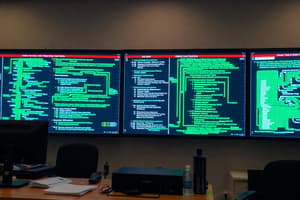Podcast
Questions and Answers
Which CTL property expresses that it is always the case that if p1 holds, then eventually p2 will hold?
Which CTL property expresses that it is always the case that if p1 holds, then eventually p2 will hold?
- AX(p1 ⇒ EF(p2))
- EF(p1 ⇒ AG(p2))
- AG(p1 ∧ EF(p2))
- AG(p1 ⇒ EF(p2)) (correct)
In the context of the producer-consumer problem, which CTL property expresses that the consumer will eventually consume the product?
In the context of the producer-consumer problem, which CTL property expresses that the consumer will eventually consume the product?
- AG(consumer_consumes)
- EF(consumer_consumes) (correct)
- AX(consumer_consumes)
- EF(¬ consumer_consumes)
Given the CTL property AX(p1 ∨ p2), what does this imply about the next state?
Given the CTL property AX(p1 ∨ p2), what does this imply about the next state?
- In all next states, either `p1` or `p2` (or both) must hold. (correct)
- In some next states, either `p1` or `p2` can hold.
- In the next state, neither `p1` nor `p2` may hold.
- In all next states, both `p1` and `p2` must hold.
When using model checking with CTL, what is the primary goal?
When using model checking with CTL, what is the primary goal?
In the context of the producer-consumer problem, which CTL property best represents the statement: 'If the producer is ready to produce, then in the next state it always puts its product into the buffer'?
In the context of the producer-consumer problem, which CTL property best represents the statement: 'If the producer is ready to produce, then in the next state it always puts its product into the buffer'?
Which statement correctly describes the difference between the temporal operators 'Gp' and 'Fp'?
Which statement correctly describes the difference between the temporal operators 'Gp' and 'Fp'?
In Computation Tree Logic (CTL), how are temporal operators and path quantifiers typically combined?
In Computation Tree Logic (CTL), how are temporal operators and path quantifiers typically combined?
Given a computation path where p is true at states s0 and s2, and q is true at s3, which of the following is true regarding the temporal operator pUq?
Given a computation path where p is true at states s0 and s2, and q is true at s3, which of the following is true regarding the temporal operator pUq?
Consider a state s0 in a computation path. Which of the following best describes when Xp (next p) holds?
Consider a state s0 in a computation path. Which of the following best describes when Xp (next p) holds?
In the context of formal verification, what is the significance of combining logical operators with temporal operators and path quantifiers in Computation Tree Logic (CTL)?
In the context of formal verification, what is the significance of combining logical operators with temporal operators and path quantifiers in Computation Tree Logic (CTL)?
What is the primary purpose of formal verification in system design?
What is the primary purpose of formal verification in system design?
Which of the following best describes the role of a formal language in formal verification?
Which of the following best describes the role of a formal language in formal verification?
What is the core principle behind theorem proving as a formal verification technique?
What is the core principle behind theorem proving as a formal verification technique?
How does model checking primarily verify system properties?
How does model checking primarily verify system properties?
In the context of model checking, what is the significance of temporal logic?
In the context of model checking, what is the significance of temporal logic?
Which type of systems are best suited for formal verification using model checking?
Which type of systems are best suited for formal verification using model checking?
Consider a system property that must hold true at some point in the future. Which approach is most suitable for verifying this property?
Consider a system property that must hold true at some point in the future. Which approach is most suitable for verifying this property?
A safety-critical system requires that a specific resource is always released within 10 time units after being acquired. Which formal verification technique would be most appropriate to verify this?
A safety-critical system requires that a specific resource is always released within 10 time units after being acquired. Which formal verification technique would be most appropriate to verify this?
Which of the following scenarios best illustrates a safety property in the context of a system's behavior?
Which of the following scenarios best illustrates a safety property in the context of a system's behavior?
In the context of formal verification, what is the primary goal of model checking?
In the context of formal verification, what is the primary goal of model checking?
Consider a system that manages bank accounts. Which of the following represents a liveness property for this system?
Consider a system that manages bank accounts. Which of the following represents a liveness property for this system?
In Temporal Logic, what is the key difference in how Computation Tree Logic (CTL) and Linear Temporal Logic (LTL) view system computations?
In Temporal Logic, what is the key difference in how Computation Tree Logic (CTL) and Linear Temporal Logic (LTL) view system computations?
In CTL, what does the path quantifier 'E' (or ∃) signify when applied to a temporal property?
In CTL, what does the path quantifier 'E' (or ∃) signify when applied to a temporal property?
Which of the following CTL expressions asserts that property 'p' will hold eventually on all computation paths?
Which of the following CTL expressions asserts that property 'p' will hold eventually on all computation paths?
Which CTL operator signifies that a property p holds continuously along a path?
Which CTL operator signifies that a property p holds continuously along a path?
In CTL, what does the expression E(p U q) mean?
In CTL, what does the expression E(p U q) mean?
Flashcards
pWq (Weak Until)
pWq (Weak Until)
pWq is true if p holds until q holds, but q is not required to hold.
Gp (Globally)
Gp (Globally)
Gp is true if p holds at all states along a computation path.
Fp (Eventually)
Fp (Eventually)
Fp is true if p holds at some state along a computation path.
Xp (Next)
Xp (Next)
Signup and view all the flashcards
pUq (Until)
pUq (Until)
Signup and view all the flashcards
Formal Verification
Formal Verification
Signup and view all the flashcards
Purpose of Formal Verification
Purpose of Formal Verification
Signup and view all the flashcards
Properties in Formal Verification
Properties in Formal Verification
Signup and view all the flashcards
Theorem Proving
Theorem Proving
Signup and view all the flashcards
Model Checking
Model Checking
Signup and view all the flashcards
What is Model Checking?
What is Model Checking?
Signup and view all the flashcards
System Properties in Model Checking
System Properties in Model Checking
Signup and view all the flashcards
Symbolic Algorithms
Symbolic Algorithms
Signup and view all the flashcards
CTL Operator Combinations
CTL Operator Combinations
Signup and view all the flashcards
CTL Logical Operators
CTL Logical Operators
Signup and view all the flashcards
CTL and LTL
CTL and LTL
Signup and view all the flashcards
Safety Properties
Safety Properties
Signup and view all the flashcards
Liveness Properties
Liveness Properties
Signup and view all the flashcards
Temporal Logic
Temporal Logic
Signup and view all the flashcards
Computation Tree Logic (CTL)
Computation Tree Logic (CTL)
Signup and view all the flashcards
Linear Temporal Logic (LTL)
Linear Temporal Logic (LTL)
Signup and view all the flashcards
Path Quantifier: A (∀)
Path Quantifier: A (∀)
Signup and view all the flashcards
Path Quantifier: E (∃)
Path Quantifier: E (∃)
Signup and view all the flashcards
Study Notes
- Formal Verification is checking a system's correctness against its specification
- It proves or disproves system properties using formal methods
Types of Formal Verification
- Formal Verification is divided into Theorem Proving and Model Checking.
- Theorem proving techniques prove mathematical/logical statements related to the system, based on predicate logic
- They involve checking the logical consequence of a set of statements (axioms and hypotheses)
- Model checking techniques verify system properties against the generated state space of the system's behavioral model
- Emphasis is placed on model checking of system properties
Model Checking
- Verifies finite-state concurrent systems formally
- System properties are expressed as temporal logic formulas
Model checking's process:
- Efficient symbolic algorithms check properties against the system-defined model's state space
- Determine if the specification holds
- All reachable states of a system are inspected to find states which don't satisfy a correctness criterion
Properties Verified
- System properties verified via model checking fall into two categories: safety and liveness
- Safety properties assert that bad system behavior must not occur
- Liveness properties assert that good system behavior must occur
Example Properties
- For software performing math operations, safety means the software never fails
- Liveness means input operations are executed successfully
Temporal Logic Overview
- Temporal logic uses rules and symbols to represent and reason about propositions regarding time
- Different temporal logics have different views of computation
Types of Temporal Logic
- Computation Tree Logic (CTL) views system computation as a tree
- CTL allows system movement into different paths for future states
- Linear Temporal Logic (LTL) views system computation as a set of paths
- LTL moves the system along one direction (path) to the future
When determining if you should use CTL or LTL
- The choice between CTL and LTL depends on the problem being examined, for example, sequential or concurrent behavior
CTL and Quantization
- CTL allows over paths whereas LTL does not
- LTL offers a greater ability to describe individual paths
CTL (Computation Tree Logic)
- CTL is used to describe path navigation from a given state using path quantifiers, logical, and temporal operators
Logical Operators
- (¬), (^), (V), (⇒), and (⇔).
Temporal Operators
- The temporal operators of CTL are distinguished into path quantifiers and linear temporal operators
- Path quantifiers include: A (∀) for all computation paths from a state, and E (∃) for some computation path(s) from a state
- Linear temporal operators describe properties along a path
Common Linear Temporal Operators
- Gp: p holds at every state (always) along the path
- Fp: p holds at some state along the path
- Xp: p holds at the next state of the current one along the path
- pUq: p holds until q holds at some state along the path
- pWq: similar to U, but q doesn't need to hold
CTL Syntax
- CTL syntax is based on combinations of temporal operations and path quantifiers, along with logical operator use
- Common combinations include: AG, AF, AX, EG, EF, and EX
- Logical operators are used with the aforementioned combinations to define properties like:
- AG(¬ p)
- EF (p1 ^ P₂)
- AX (p₁ V P₂)
- AG(p₁ ⇒ EF(p2))
Summary
- Formal Verification detects system errors relative to the system's specification
- Model checking uses CTL or LTL to investigate system properties
Studying That Suits You
Use AI to generate personalized quizzes and flashcards to suit your learning preferences.




